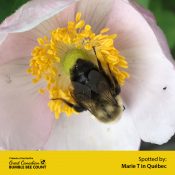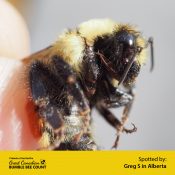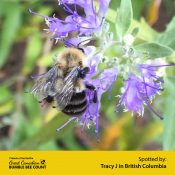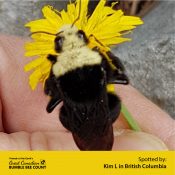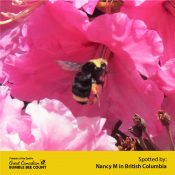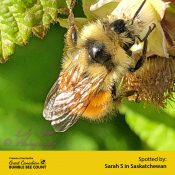The Great Canadian Bumble Bee Count
Sadly, this year, limited resources mean we will not be able to offer you one of our favourite campaigns, the Great Canadian Bumble Bee Count. However, there are other ways you can continue to be involved with our Bee Cause campaign:
1) Have fun learning how to identify some of Canada’s native bumble bees attracted to your flower patch and other outdoor spaces by downloading a free copy of the our Census cards for either Eastern Canada or Western Canada. These Census cards are in demand by educators for schools and outdoor education programs and, we’re advised, there are too few learning materials about Canada’s wild, native bees.
2) One of the most positive steps that you can take to support pollinators is to plant native species—in yards, on balconies, in community gardens, at community centres…all over!” says Lorraine Johnson, garden expert and co-author of e-guide “A Flower Patch for the Rusty-Patched Bumblebee: Creating Habitat Gardens for Native Pollinators in the Greater Toronto Area”. While written for the GTA area, much of the content is relevant everywhere.
3) Have a great shot of a bumble bee? Email a copy of the photo to foe {at} foecanada.org to add to our library of native bumble bees.
What is the Great Canadian Bumble Bee Count?
Just like governments need a census to know what’s happening with its citizens, as well as their homes, families and jobs, we think bumble bees need their own census. Not enough is known about wild, native bees in Canada, and what scientists do know is worrying.
Bumble bees are the most well known of Canada’s wild, native bees though getting to know the 40+ species is a challenge. To help identify your bumble bee photo, you can download a census card for Western Canada or Eastern Canada.
We know bees are facing many stressors – habitat loss, pesticide exposure and disease are big ones but so is climate change. In fact, the United Nations describes the loss of insects worldwide as an ongoing “insect apocalypse”.
Why take part in the Great Canadian Bumble Bee Count?
As many as one-third of North American bumble bee species are in decline.
The Great Canadian Bumble Bee Count aims to raise awareness about the importance and conservation requirements of Canada’s over 40 species of bumble bees. Bumble bees are crucial pollinators. Because they are capable of buzz pollination, they are particularly effective at pollinating a number of wildflowers, fruits and vegetables.
By taking part in the Great Canadian Bumble Bee Count, you can help us learn more about bumble bees and their needs.
Canada’s first officially designated endangered bee, the Rusty-patched bumble bee was last seen in 2009 in Pinery Provincial Park near Grand Bend, Ontario. This is a grim situation for a once abundant bumble bee – nothing to celebrate as a first.
Early in 2019, scientists from York University reported their research on the American bumble bee (pictured) – a species once more commonly seen in Southern Ontario. The scientists say this bee is at risk of extinction and it’s currently not protected in any way despite the drastic decline. Scientists, Dr. Sheila Colla, Victoria McPhail and others, found that the American bumble bee’s area of occurrence has decreased by about 70 percent and its relative abundance fell by 89 percent from 2007-2016 compared to 1907-2006.
Gypsy cuckoo
bumble bee
Bombus bohemicus
ENDANGERED
Macropis cuckoo
bumble bee
Epeoloides pilosula
ENDANGERED
Yellow-banded
bumble bee
Bombus terricola
SPECIAL CONCERN
Sable island sweat
bumble bee
Lasioglossum sablense
THREATENED
Western bumble bee
Bombus occidentalis
THREATENED
(proposed)
Western bumble bee
Bombus mckayi
SPECIAL CONCERN
(proposed)
- The Gypsy Cuckoo bumble bee once found in all provinces and territories except Nunavut and the rare Macropis Cuckoo bumble bee from Nova Scotia have been designated “endangered”;
- The Yellow-banded bumble bee found all across Canada is designated “special concern”. Scientists report that it has recently declined by at least 34% in areas of Southern Canada;
- The Sable Island sweat bee is designated “threatened”.
However, the Western bumble bee Occidentalis found in British Columbia, Alberta, and Saskatchewan has no schedule or status under the Species at Risk Act and is still proposed to be designated “threatened” and similarly for the Western Bumble Bee mcKayi found in the Yukon, NWT and BC and proposed to be special concern. Both sub-species are known to carry the highest parasite loads of any bumble bees in North America and are threatened by pathogen spillover from commercially managed bumble bees escaping from greenhouse operations.
If you spot a bumble bee – especially one of the bumble bees in trouble – please take a picture and email it to foe {at} foecanada.org



